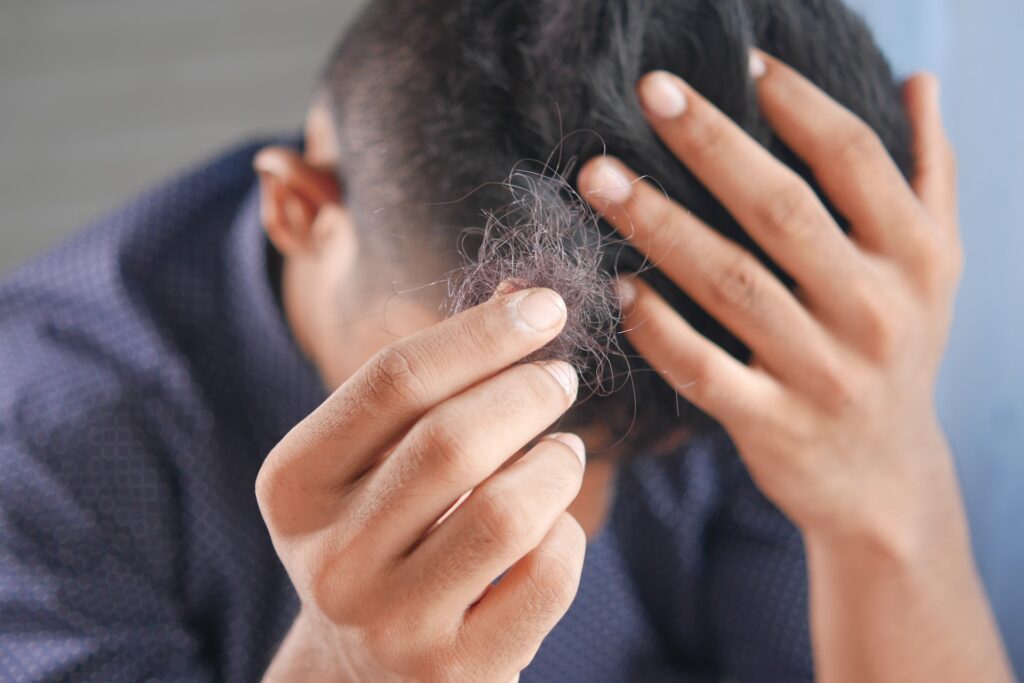What is DHT?

Dihydrotestosterone, also known as DHT, is a sex hormone linked to hair loss in males and females. In a healthy amount, DHT contributes to healthy body cycles, but when it is produced in excess, that’s when hair loss occurs.
This hormone comes from testosterone, which males can thank for muscle growth, deep voice, body hair, reproductive organs, and fat storage. These hormone levels impact fertility and overall hair development.
High production of DHT often links to male pattern baldness; however, as women also produce testosterone, it is also linked to female pattern baldness. According to MyHealthGuide, approximately 10 percent of testosterone in all adults converts to DHT.
High DHT production can sometimes go unnoticed, specifically for men. Males often don’t show many signs of high DHT levels besides hair loss. Women, on the other hand, show physical signs of overproduction, including:
- Increased body, facial, and pubic hair
- Halted menstrual cycles
- Increased acne
- Abnormal genitalia changes
Conversely, too little DHT can adversely affect men, not women. Females with low levels may experience delayed puberty or diminished pubic hair. On the other hand, males can undergo physical changes such as:
- Reduced genitalia
- Limited body hair
Table of Contents
How You Can Reduce DHT Levels
There are several ways to remove DHT from the scalp. The most popular ones are below:
Diet
What you eat impacts your body’s performance and development—DHT levels are no different. To maintain healthy hormone levels, eat vegetables rich in zinc that contain phytosterol, which blocks Dihydrotestosterone production. Some examples include spinach, shiitake mushrooms, green peas, lentil sprouts, lima beans, broccoli, asparagus, sweet corn, etc.
Foods containing lycopene are also natural blockers for Dihydrotestosterone production; these foods include guavas, tomatoes, grapefruit, watermelon, papaya, red bell peppers, green tea, coconut oil, onions, and turmeric are also wonderful for hair growth.
Lifestyle Adjustments
To no surprise, exercise is a wonderful blocker for hormone production. In addition, quitting smoking, reducing stress, resting, and getting scalp massages help keep DHT levels healthy.
To take the massaging a step further, massaging emu oil and pumpkin oil directly to the scalp can help block the hormone. Scalp nurturing and protection is everything regarding hair growth/preventing loss, so exfoliating your scalp is key.
That’s when you should massage your scalp.
While you can use store-bought mixtures to apply to your scalp, you can also make your at-home exfoliants using sugar, egg, mayonnaise, emu oil, and pumpkin seed oil. It helps rid dead skin and excess sebum, cleaning the skin and keeping it healthy.
Shampoo DHT Away
When picking out the right shampoo, ensure you find one with active ingredients for fighting DHT. Find products that include ketoconazole, saw palmetto, and pumpkin seed oil to get the finest bang for your buck.
Medicine
Another option is to take medicines that are 5AR inhibitors. This medicine prevents your testosterone from converting to DHT, including topical tretinoin minoxidil, Dutasteride, and Finasteride.
What else can you do?
You can opt for minoxidil, Finasteride, Dutasteride, or a hair transplant.
Try hair transplant alternatives if you’re afraid of the pain and the cost.
Are the side effects of removing DHT?
Yes, removing DHT might sound like a no-brainer when you have hair loss. You might want to check out the DHT blocker side effects and, specifically, DHT blocker shampoo side effects.
References
BS; Hugo Perez. “Ketoconazole as an Adjunct to Finasteride in the Treatment of Androgenetic
Alopecia in Men.” Medical Hypotheses, U.S. National Library of Medicine, https://pubmed.ncbi.nlm.nih.gov/14729013/.
Rhodes T;Girman CJ;Savin RC;Kaufman KD;Guo S;Lilly FR;Siervogel RM;Chumlea WC;
“Prevalence of Male Pattern Hair Loss in 18–49-Year-Old Men.” Dermatologic Surgery: Official Publication for American Society for Dermatologic Surgery [Et Al.], U.S. National Library of Medicine, https://pubmed.ncbi.nlm.nih.gov/9865198/.
Also Read: 7 women’s day gift ideas for tech savvy women in your life







